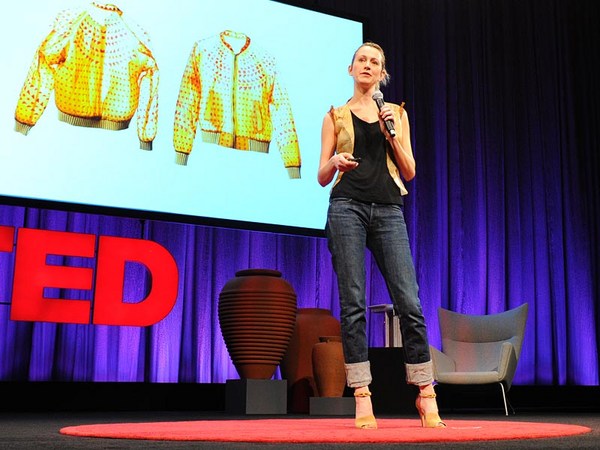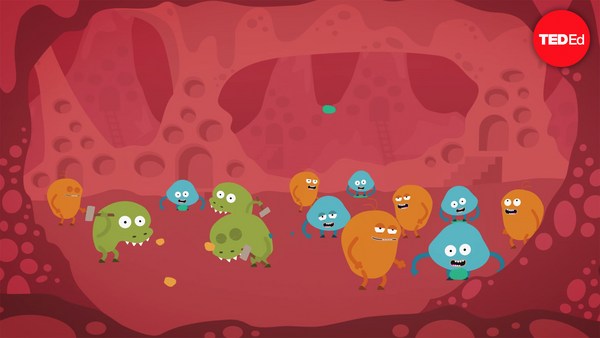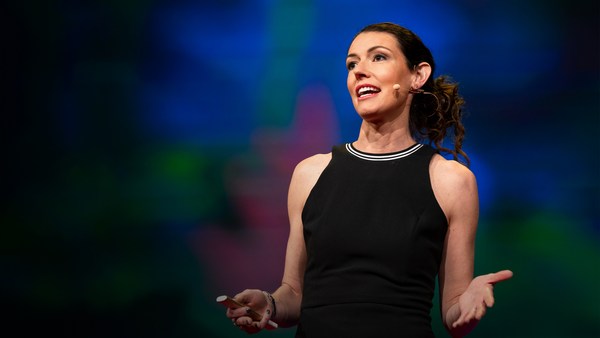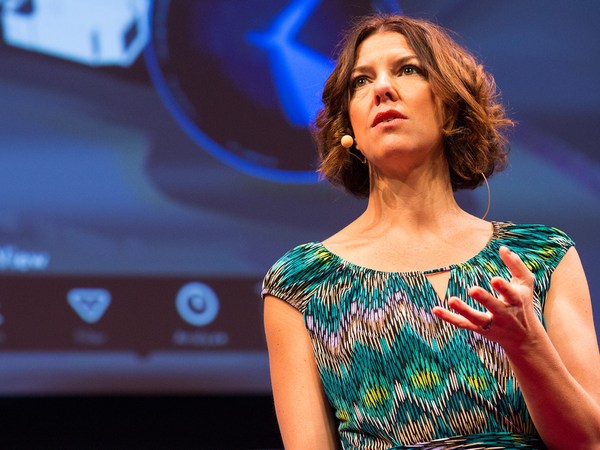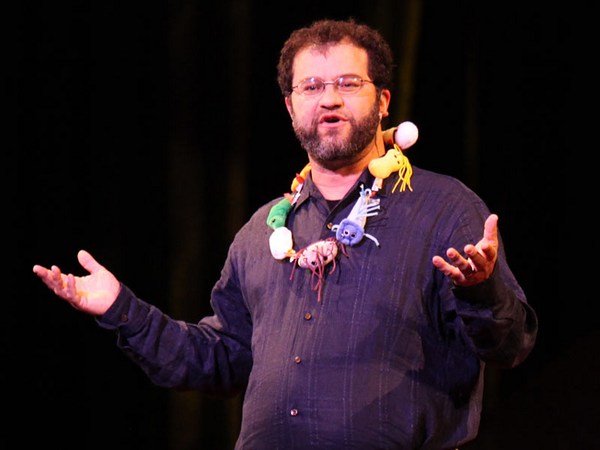I started life as a fashion designer, working closely with textile designers and fabric suppliers. But today, I can no longer see or talk to my new collaborators, because they're in the soil beneath our feet, on the shelves of our supermarkets and in the beer I'm going to drink when I finish this talk. I'm talking about microbes and designing with life.
Fifteen years ago, I completely changed both what I worked with and how I worked after a revelatory collaboration with a biologist. Our project gave me a different perspective on life, introducing a whole new world of possibility around how we can design and make things. I discovered a radical manufacturing proposition: biofabrication. Literally, fabricating with biology.
What does that mean? Well, instead of processing plants, animals or oil to make consumer materials, we might grow materials directly with living organisms. In what many are terming "the Fourth Industrial Revolution," we're thinking about the new factories as being living cells. Bacteria, algae, fungi, yeast: our latest design tools include those of biotechnology.
My own journey in biofabrication started with a project called "Biocouture." The provocation was that instead of growing a plant, like cotton, in a field over several months, we could use microbes to grow a similar cellulose material in a lab in a few days. Using a certain species of bacteria in a nutrient-rich liquid, we fermented threads of cellulose that self-organized into a sheet of fabric. I dried the fabric I had grown and cut and sewed it into a range of garments, shoes and bags. In other words, in one lab we grew materials and turned them into a range of products in a matter of days. And this is in contrast to currents methods of fabric production, where a plant is grown, just the cotton part is harvested, processed into a yarn, woven into a fabric and then potentially shipped across oceans before being cut and sewn into a garment. All of that can take months.
So these prototypes indicated a field offering significant resource efficiencies. From reducing the water, energy and chemistry needed in the production of a material, through to generating zero waste, we grew fabrics to finished form -- if you like, "biological additive manufacture."
Through biofabrication, I had replaced many intensive man-made steps with one biological step. And as I engaged with this living system, it transformed my design thinking. Here was biology, with no intervention from me other than designing initial conditions for growth, efficiently producing a useful, sustainable material.
So now I can't help but see all materials through the lens of biofabrication. In fact, there's a growing global community of innovators rethinking materials with biology. Multiple companies are now growing mushroom materials, but not literally mushrooms -- using mycelium, which is the root system of fungi, to bind together agricultural byproducts. It's a process that's been described as "nature's glue." A common way to do this is to take a 3-D mold, fill it with a waste crop like corn stalks or hemp, add water, wait a few days for the mycelium to grow throughout, remove the mold, and you're left with a grown 3-D form.
Incredibly, we can grow all kinds of structures using living organisms, from foams that can replace plastics in footwear, to leather-like materials without animals. Furniture, flooring -- all are currently being prototyped. Fungi are able to grow materials that are naturally fire retardant, without any chemicals. They're naturally hydrophobic, meaning they won't absorb water. They have higher melt temperatures than plastics. Polystyrene can take thousands of years to degrade. Mushroom packaging materials can be naturally composted in your back garden in as little as 30 days. Living organisms are transforming waste into cost-competitive, performance-matching materials that can start to replace plastics and other CO2-emitting materials.
And once we start growing materials with living organisms, it starts to make previous methods of manufacture seem illogical. Take the humble house brick. The cement industry generates around eight percent of global CO2 emissions. That's more than all the planes and ships each year. The cement process requires materials to be fired in a kiln at over 2,000 degrees Fahrenheit. Compare this to bioMASON. They use a soil microbe to transform loose aggregates, like sand or crushed stone, into a biofabricated, or biocement, brick. Their process happens at room temperature, in just a couple of days. Think: hydroponics for bricks. An irrigation system feeds nutrient-rich water to trays of bricks that have been inoculated with bacteria. The bacteria produce crystals that form around each grain of sand, locking together all the loose particles to form a solid brick. We can now grow construction materials in the elegant way nature does, just like a coral reef. And these biofabricated bricks are nearly three times stronger than a concrete block. And in stark contrast to traditional cement production, they store more carbon than they make. So if we could replace the 1.2 trillion fired bricks that are made each year with biofabricated bricks, we could reduce CO2 emissions by 800 million tons every year.
(Applause)
Beyond growing materials with living organisms, we're even starting to design products that encourage their growth. And this comes from the realization that the very thing we've been trying to marginalize -- life -- might actually be our greatest collaborator. To that end, we've been exploring all the ways that we can grow healthy microbes in our own ecosystems. A great example of this is architects who are imagining the skin of a building to function like the bark of a tree. But not as a cosmetic green layer. They're designing architectural barks as hosts for evolving ecologies. These surface structures are designed to invite life in. And if we applied the same energy we currently do suppressing forms of life towards cultivating life, we'd turn the negative image of the urban jungle into one that literally embodies a thriving, living ecosystem. By actively encouraging surface interactions with healthy microbes, we could improve passive climate control, stormwater management and even reduce CO2 emissions by lowering the energy used to heat or cool our buildings.
We're just beginning to realize the potential of nature-based technologies. I'm excited that we're starting to design and biofabricate a new material world.
It's one that moves away from the exploitation of nonrenewable resources to working with the original, renewable life. Instead of designing out life, we're designing with it and for it. Packaging, fashion, footwear, furniture, construction -- biofabricated products can be grown close to centers of demand, with local resources, less land, energy, and even harnessing industrial waste streams.
It used to be that the tools of biotechnology were the preserve of powerful, multinational chemical and biotech companies. In the last century, we expected material innovation to come from the likes of DuPont, Dow, BASF. But this 21st-century material revolution is being led by start-ups with small teams and limited capital. And by the way, not all their founders have science degrees. They include artists, architects and designers. Over a billion dollars has already been invested in start-ups biofabricating consumer products.
I don't think we have a choice but to biofabricate our future. From the jacket you're wearing to the chair you're sitting in to the home you live in, your designed material world shouldn't compromise your health or that of our planet. If materials can't be recycled or naturally composted at home, we should reject them.
I'm committed to making this future a reality by shining a light on all the amazing work being done today and by facilitating more interactions between designers, scientists, investors and brands. Because we need a material revolution, and we need it now.
Thank you.
(Applause)
